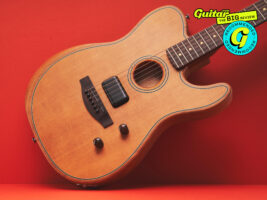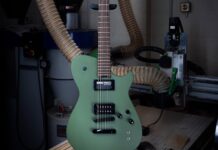
Fender Acoustasonic Standard Telecaster review: “these are sounds you don’t hear in a live context very often”
$629/£569, fender.com
At this point, you probably already know how you feel about the Fender Acoustasonic phenomenon. Since Fender’s hybrid acoustic-electric arrived in 2019, it’s probably been the most polarising concept the world’s biggest guitar brand has foisted on the guitar-buying public since the Katana.
READ MORE: Taylor 314ce Studio review: “Forget where the neck is made, this is every bit the US-made instrument
In truth though, a lot of opprobrium that the Acoustasonic has inspired in the last half a decade has primarily been down to how it looks. For a not-insignificant proportion of the guitar-buying public, sticking a soundhole in the middle of a Tele is akin to doodling a toothbrush moustache on the Mona Lisa.
And if that is you, I’m sorry but this review is unlikely to either change your mind, or indeed confirm your preexisting negative feelings. Because despite being a little unconvinced by the concept when it was unveiled at NAMM back in January 2019, any misgivings I had about the aesthetics were soon sidelined by the experience of using one in practice.
It might not be the perfect middle-ground between acoustic and electric guitar that Fender’s most feverish press releases may claim, but as a guitar that can provide decent electric and acoustic sounds in a live or home environment, it’s pretty bloody effective.
What’s also been impressive over the last few years is that despite the online grumbling, Fender clearly believes in this concept. Not only has the concept been expanded to include both Jazzmaster and Strat body shapes, but it’s also made its way down the pyramid, with the Mexico-made Player versions being hugely impressive when I checked one out a few years back. It’s also correlated with seeing a fair few more of these guitars in the wild being used as they were intended. Unsurprisingly the more you drop the barrier of entry, the more likely people are to take a chance on something unusual – so what if they dropped that bar even lower?
Image: Adam Gasson
Fender Standard Acoustasonic Telecaster – what is it?
You’ll have noticed that the ‘Standard’ designator has been revived by FMIC in 2025 to denote its latest attempt to blend Asian manufacture and prices with the Fender brand. Previously, this was only the outlet for leftfield Fender releases like the Starcaster or the Modern Player series, the gradual inflation of Fender’s Mexico range meant that there was a gap in the market that was filled with a new series of classic designs made by Cor-Tek in Indonesia.
The results of that were a mixture of ‘pretty good’ and ‘fine’, so the decision to add a pair of Acoustasonic guitars to that range did have me wincing a little. A bolt-on solidbody electric guitar is a damn sight easier to mass-produce than a hollowbody hybrid, and I’ve heard a few eyebrow-raising QC horror stories with the Mexico-made Player versions – would this be a bridge too far?
And what about that price? At less than $600 it’s basically half the price of the Player version. That can’t be entirely down to the reduced cost of Asian manufacturer – compromises will have to be made somewhere.
Image: Adam Gasson
For starters, the body wood is not mahogany anymore, but nyatoh – a popular and common substitute for mahogany on budget guitars. As with the Standard Telecaster, the three-piece back isn’t the most artfully matched, and the grain patterns are distinct enough that they barely look like the same species of wood, let alone the same tree. But honestly, we’re dealing with a $600 guitar here, what else do you expect? Conversely, the top is actually quite a nice bit of solid Sitka spruce, considering – the grain is straight and pretty even, with some subtle figure that I think looks pretty good.
It’s an effect helped by the thinly-applied Aged Natural finish – it’s the most unadorned of the three options at launch, but I think it’s perhaps the best. The finish is nicely applied, letting you feel the texture of the wood under your fingertips, without being so delicate that fingerprints or scuffs feel like a pressing concern.
Another big change can be found under the hood – whereas the Player Acoustasonic paired an undersaddle piezo with a Noiseless single-coil pickup, here we have a new Shawbucker humbucker in the bridge position.
The electronics themselves have also been streamlined – gone is the pickup selector switch, replaced with a master blend switch that allows you to choose exactly how much of each pickup you want at any given time.
Image: Adam Gasson
Fender Standard Acoustasonic Telecaster – build quality
Despite some of the material differences, and that huge price drop, I was pleasantly surprised with how this guitar played and felt out of the box. Body still feels nicely ergonomic in a way that a regular Tele isn’t, and the overall fit and finish of the purfling, joining and general build feels impressively solid.
The neck is a pleasingly chunky ‘Modern Deep C’ in Fender’s parlance, with a 12mm radius and 22 frets. In practice, that makes for a slightly chunkier feel than the regular Standard guitars, but still more than slinky enough for easy playing – in truth I wish they put this neck on the regular guitars. The enjoyable playing experience is further enhanced by Fender’s latest trick – rolling fingerboard edges. It’s subtle again here, but it really does make the playing experience feel more worn-in and enjoyable.
In truth, a lot of the differences between the Player and Standard Acoustasonics can be found in the neck, and not all of them are great. Gone is the lovely routed Fender logo on the Tele peghead, replaced with a slightly cheap looking mirrored affair, but the other end is more jarring.
A feature of Acoustasonics past has been a chamfered neck heel allowing easier access to the upper frets. Here however we have a standard chunky Tele-style four-bolt square heel with blank silver plate. It’s only a big deal if you are planning to spend a lot of time up the top end of the neck, and you could argue that the standard Tele arrangement hasn’t done much to put players off that. Still, it’s something that I missed when picking it up for the first time.
Image: Adam Gasson
Fender Standard Acoustasonic Telecaster – build quality
When the Acoustasonic first launched it had all sorts of fancy sonic options under the hood – including various modelled acoustic sounds to choose from and blend them accordingly. It was a bit much, in all honesty, and it was no surprise to see the Player version simplify things a great deal. Here however, we’re stripping things back even further – with none of that modelling stuff at all, and not even a pickup selector to work with.
All the control is based around that blend knob – at one end it’s all piezo, at the other it’s all electric, and you can find your happy place somewhere in between. The only other control is a volume knob, which feels somewhat superfluous in this context, you have to say. It’s a somewhat frustrating layout, to be honest – the ability to switch between all-electric and all-acoustic at the flick of a selector switch was useful on the Player version, and sweeping a knob is nowhere near as immediate.
Mercifully, Fender abandoned the endlessly annoying built-in rechargeable battery of the American version long ago and as with the Player here you power the whole thing with a 9V battery accessed by a hatch in the back of the rear control cavity.
Image: Adam Gasson
Fender Standard Acoustasonic Telecaster – sounds
In my review of the Acoustasonic Player Jazzmaster, I extolled the virtue of the guitar as the ultimate couch guitar – after all, it has the easy playability of an electric with the tonality of an acoustic, and the family-friendly volume of a semi.
It’s unlikely that anyone is buying an Acoustasonic purely to play on the sofa, but I’d be surprised if it hadn’t ended up in that role in a lot of homes that own one. That being said, the Standard continues the Acoustasonic’s impressive track record of sounding much bigger and fuller than its body shape should allow. It’s perhaps not as loud as the Jazzmaster I tested a few years ago, but the Stringed Instrument Resonance System (aka the soundhole) once again does an impressive job of making it sound like an acoustic, but just quieter.
Plugging in, and with no digital ‘images’ (Fishman’s term for models that aim to mix the mic’d sound of an acoustic with the piezo) colouring the tone here, the onus really is on that undersaddle transducer to sound decent, and mercifully it does – with a surprising amount of bottom-end and minimal piezo honk. It’s not going to go toe-to-toe with pickup systems that cost more than this guitar of course, but it sounds better than most entry-level pickup systems despite its diminutive size.
What is a little disappointing is what happens when you plug it into an electric amp. It’s perhaps not surprising that an acoustic pickup loses some of the pizazz when plugged into an amp set up for raucous electric guitar… but there is the small matter of that honkin’ great humbucker in the bridge. It seems weird to me that you wouldn’t try to voice the pickup to sound better with an electric amp given its stated purpose. Maybe the thinking is that you’ll always have an ABY switch or a modelling solution to cater to each sound… but it just seems weird to me.
The Shawbucker itself is punchy and fun, in a polite kinda way – this is a humbucker on an acoustic guitar don’t forget so expecting it to soak up endless lashings of gain is perhaps unrealistic. As with the other Acoustasonics, the sweet spot really is found in the blending – it adds real depth and presence to your sound that occupies neither the fully electric or fully acoustic world. This feeling is enhanced with the addition of some subtle time-based effects – these are genuinely sounds you don’t hear in a live context very often, and they’re hugely compelling in practice.
Image: Adam Gasson
Fender Standard Acoustasonic Telecaster – should I buy one?
The more prescient question is probably, ‘Have you ever been intrigued by an Acoustasonic before?’ Because if the answer is any kind of yes, you no longer have any excuse not to dip your toe in and see what the fuss is about. I would never accuse a giant multinational corporation of having anything so human as ‘guts’, but it has taken a lot of organisational fortitude for Fender to ignore the naysayers and persist with the Acoustasonic programme for over half a decade now. And to gradually make it more and more accessible along the way. The Standard is probably the final word in that direction (it’s hard to see what else could be trimmed to make a Squier version), and it’s a definitive one. Try it.
Fender Standard Acoustasonic Telecaster – alternatives
A lot of the thinline acoustic guitars out there are more classical crossovers, which I think is a different ballgame entirely, and so many of the Standard’s rivals are found in Fender’s own stable. You have the Acoustasonic Player Telecaster ($1,199/£1,029), of course, but also if you want your guitar to be more acoustic-shaped the Highway Parlor ($999/£819) is a stage-ready option. If you want a small, stage-ready acoustic with no sonic compromises, LR Baggs’ AEG-1 ($1599/£2,099) is hugely impressive – but it’s acoustic only.
The post Fender Acoustasonic Standard Telecaster review: “these are sounds you don’t hear in a live context very often” appeared first on Guitar.com | All Things Guitar.
Source: www.guitar-bass.net












